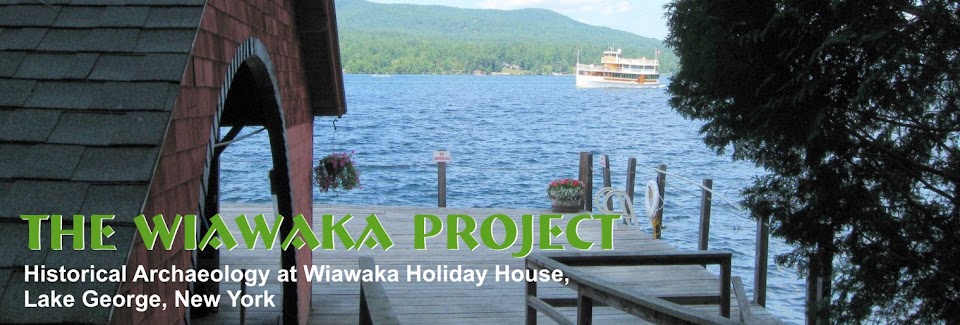Name Change!
Wiawaka has changed it's name from Wiawaka Holiday House to Wiawaka Center for Women to better reflect their current mission and programming.
 |
| New logo. |
Volunteer Opportunities for Summer 2014
People have started volunteering to come excavate at Wiawaka this summer. I am looking forward to seeing old friends and meeting new ones as we look for evidence of the various groups of people at Wiawaka in the early 20th century: visitors, organizers, and staff. A special workshop will be offered for volunteers... stay tuned, I'll post more when the details are set!
For more information on volunteering to help with the archaeology program at Wiawaka this summer, check out this post: http://www.wiawakaproject.com/2014/03/join-us-for-2014-archaeology-volunteer.html
What I've Been Up To...
It's been a busy spring. Last week I spent some time in Copper Country, on the Keweenaw Peninsula of Michigan (it's the uppermost point of the Upper Peninsula) as part of the Park Break Fellowship program of the George Wright Society. Myself and seven other graduate students from across the country spent the week with staff and Park Partners of Keweenaw National Historical Park and Isle Royal National Park. We worked to develop ways that these parks could engage with the public to increase awareness and stewardship of the rich archaeological heritage in the area.
 |
| A 17-ton deposit of pure copper from the Keweenaw. Me for scale. |
This region has an incredible history. There is archaeological evidence that Native Americans were mining and using the almost pure copper that naturally occurs in this region to make tools and ornaments that were traded across the North American continent at least 7,000 years ago. Recent analysis suggests that they were mining and working copper here as early as 8,000 years ago, making the Keweenaw and Isle Royal the sites of the earliest metal working in the world.
 |
| Touring the Quincy Mine Hoist House. This hoist was used to lower workers into the Quincy Mine and to raise buckets (called kibbles) full of copper from deep in the ground. This building is enormous. It was one of the first built with reinforced concrete. It is open for tours, and you can go into the mine itself! |
In the historic period, mining companies used the Native mines as indicators of where to sink their mines, and industrial copper extraction boomed here in the second half of the nineteenth- and into the early twentieth century, when the copper began to run out. Copper from this area was used in wires that connected the nation via telegraph and telephone, was turned into munitions for the Civil War, minted into pennies, and even shipped to France and returned to the United States as cladding on the Statue of Liberty. People came from around the world to work in the mines, finding ways to live and work together largely peacefully, despite often deep language and cultural differences. Struggles between workers who wanted to unionize and the mining companies and other business interests in the area were ongoing. They came to a head in 1913, when the National Guard was called in to support the mining interests. Later that year, as miners and their families were celebrating the Christmas holidays upstairs in the local Italian Hall, someone yelled "Fire!" In the rush to get out of the building, people crowded into the stairwell and pushed against the doors -- doors that were designed to open inward. Over 70 people, mostly children, died in the crush. There was no fire.
After the mining boom, the economy of the Keweenaw declined. The landscape is dotted with remnants of the copper boom, from intact structures to ruins, mine shafts to waste rock piles. The region now draws tourists to enjoy its history, unique geography, and outdoor activities (in the Porcupine Mountains at the western end of Copper Country, you can hike into some of the oldest surviving growth forest in the country). While in Calumet, Hancock, and Houghton I enjoyed excellent hospitality, ate excellent food, and very much enjoyed the locally produced coffee and beer. Long story short: If you have the opportunity to visit Copper Country on the Keweenaw, take it!
What's Next?
On April 24, I will be presenting a paper on my research at Wiawaka at the Society for American Archaeology in Austin, Texas. I will be exploring the differences between how women presented themselves in the single-gender environment of Wiawaka as compared to how they presented themselves when back in the mixed-sex world of work and home back in the cities.
"Beware the Little Flaws That Make One Homely": The Interplay of Intimacy, Sexuality, and Gender at an Early Twentieth Century Women's Retreat.
An assortment of toiletries from an early twentieth century privy deposit provides an intimate glimpse of guest experience at a women's retreat on the shores of Lake George, New York. Founded in 1903, Wiawaka Holiday House provided affordable vacations for single working women free from the potentially corrupting presence of men. Drawing on queer theory, these toiletries are used to explore the relationships between sexuality and gender expression/performance in the context of this single-gender environment and what the implications are for understanding these relationships once the women returned to their lives in the cities.
